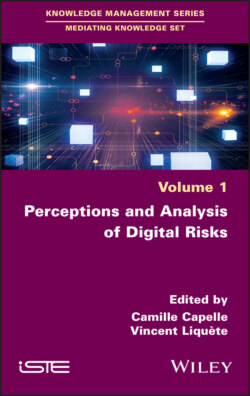Читать книгу Perceptions and Analysis of Digital Risks - Группа авторов - Страница 8
Digital risks and the context of education
ОглавлениеWhat do we mean by “digital risks”? The expression brings into play both the informational character of human activities, its technological and social space, and the human factors driving the activity. They concern the informationalization of human activities and the relationship to the information regime. At different scales, micro (that of the digital subject), meso (that of the learning devices) and macro (that of the generalized register of interactions), it puts a strain on informational ecology. Digital risks now belong to both the generalized digital transposition and the activity itself that unfolds in the uses, their “sociodynamics” (according to A. Moles’ expression), where there are close links between social issues and knowledge.
The recognized and stated risks overlap with a multidimensional set of different registers encountered in an informational ecology: “the technical risk (computer security); the social (equality, safety) and political risk (security, indoctrination); the cognitive and psychological risk (educability); the ethical and legal risk (respect for rights, digital identity, e-reputation, but also online harassment related to this practice); the risk related to health (static activity, caution with regard to radio waves, lack of sleep due to blue light), etc.”2. The informational risk is more often associated with informational effects in the sphere of knowledge, economy, political information, data use or an ecology of attention3. The plurality of the stated risks is to be compared with the global modality of risk in our modes of thinking and acting in a digital context. Each of the risks identified is part of a context of use; it refers to a specific link between perception and activity. For example, the informational scenarios stage the construction of knowledge and integrate the perception of the different risks mentioned by the contributions to the work into the uses. But, through these contexts, risk posture, its perception, the conduct of the activity, from prevention to risk-taking, make it, beyond the simple attribution to the digital of the risks incurred, a reflexive and responsible occurrence of each person’s activity.
The educational context, between mediations and practices, creates a particular tension. In the relationship between teaching and learning, education encounters the risks brought about both by technological and social transformation and by human activities that have moved or developed in the digital world. How can we escape a paradoxical and antagonistic culture, between the need for digital technology to teach and learn on the one hand, and on the other, an overvaluation of the risks that would problematize its use? How can we build a “learner” autonomy? How can we compensate for the ethical fragility of digital technology, which seems to escape older paths of knowledge? How do teachers (and students, in their “profession”) reconcile their personal and professional practices (Capelle op. cit.)? How can the desire to teach turn into the risk of teaching (Cordier 2017)?4 These questions, and others, lead us to a dialogue between practice and research in this book.
